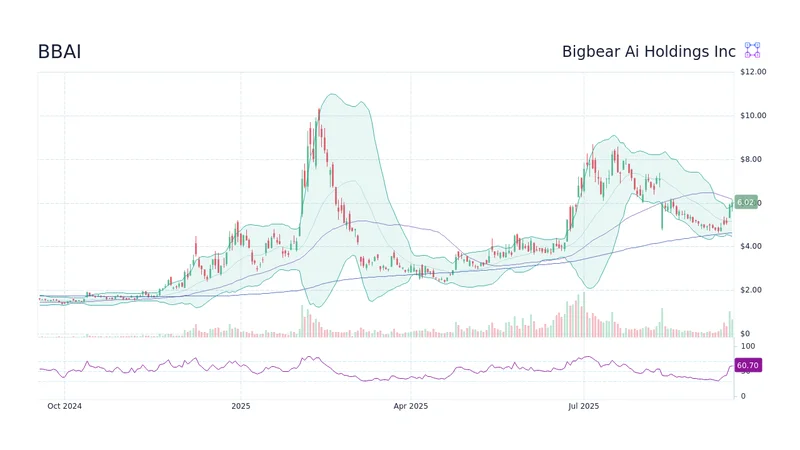BigBear.ai Stock: Q3 Results & Ask Sage Acquisition Impact
BigBear.ai's Big Bet: Is Ask Sage a Lifeline or a Distraction from the Core Numbers?
BigBear.ai (NYSE: BBAI) recently dropped its third-quarter 2025 results, and if you just skimmed the headlines, you might think everything’s coming up roses. CEO Kevin McAleenan was "thrilled" to announce the definitive agreement to acquire Ask Sage, painting a picture of a secure, integrated AI platform ready to tackle defense and national security needs. This was detailed in the BigBear.ai Announces Third Quarter 2025 Results and Definitive Agreement to Acquire Ask Sage. It sounds impressive, doesn't it? A "cutting-edge and fast-growing Generative AI platform" with over 100,000 users. But as always, the real story lives in the numbers, and those numbers often tell a different, more nuanced tale.
My analysis of the latest filing suggests a company in a fascinating, if precarious, balancing act. On one hand, you have the ambitious vision for a future powered by strategic acquisitions; on the other, the current financial performance shows some significant headwinds. Let’s not get lost in the marketing jargon. What we're seeing is a company looking to pivot aggressively while its foundational operations are, to put it mildly, struggling. Revenue for the third quarter of 2025 dipped a full 20% to $33.1 million, down from $41.5 million in the same quarter last year. That’s not a minor fluctuation; that's a substantial decline, primarily attributed to lower volume on certain Army programs. Gross margin also took a hit, slipping from 25.9% to 22.4%. These aren't just points on a chart; they represent reduced operational efficiency and less money flowing to the bottom line from core services.
Now, about that reported net income of $2.5 million for Q3 2025, a stark contrast to the $15.1 million net loss from Q3 2024. At first glance, it looks like a massive turnaround, a genuine win. But a closer look, the kind I always recommend, reveals something else entirely. This positive swing wasn't driven by operational brilliance or a surge in profitable contracts. Nope. It was primarily due to a non-cash change in derivative liabilities—a hefty $26.1 million swing, to be precise (a financial instrument revaluation, not actual cash from operations). Stripping out such accounting adjustments, the picture darkens considerably. Adjusted EBITDA, a metric often favored for showing true operational performance, crashed from a positive $0.9 million last year to a negative $9.4 million this quarter. That's not just a bad quarter; that’s a significant operational loss, signaling deeper issues than a simple government shutdown delay, which the CEO cited.

The Ask Sage Gambit and the Unanswered Questions
So, where does Ask Sage fit into this? CEO McAleenan champions it as "what the market has been asking for: a secure, integrated AI platform." And on paper, its reported reach—100,000 users across 16,000 government teams—sounds like a golden ticket. It's a classic move: when your core business is contracting, you acquire growth. It’s like a struggling baseball team trading away its aging stars for a promising, but unproven, rookie phenom. The potential is there, absolutely. Ask Sage could be the generative AI engine BigBear.ai needs to reignite its narrative and, more importantly, its revenue streams. But how much did this "definitive agreement" cost? And what’s the integration roadmap look like beyond a few optimistic sound bites? The official announcement can be found in BigBear.ai Announces Third Quarter 2025 Results and Definitive Agreement to Acquire Ask Sage. I've looked at hundreds of these filings, and this particular footnote about the acquisition having no material impact on 2025 financial results just makes me wonder how quickly they can actually turn this ship around.
The company's full-year 2025 revenue projection of $125 million to $140 million, notably excluding any material impact from Ask Sage, suggests that the current business trajectory continues to be challenging. They’re projecting a significant drop from last year's performance, even with the $376 million backlog. Backlog is great, but conversion to revenue, especially profitable revenue, is the real game. What’s the conversion rate looking like, and why isn't it translating into stronger current-year performance? Why are we seeing an $8 million increase in SG&A (selling, general, and administrative expenses) in the same breath as declining revenue? Is this increased spending aimed at future growth from acquisitions, or is it a sign of an inefficient cost structure that needs more aggressive trimming? These are not trivial questions; they're the bedrock of sustainable growth.
A High-Stakes Bet on Tomorrow
BigBear.ai is clearly making a high-stakes gamble on the future of AI in defense and national security, aiming to be the secure, integrated platform that connects software, data, and mission services. The acquisition of Ask Sage is the centerpiece of this strategy, a bold move to inject new life into a financial statement that, when stripped of non-cash accounting magic, looks pretty anemic right now. It’s a strategy that often works, provided the acquired asset truly delivers and the integration doesn’t become a costly quagmire. The optimism from management is palpable, but my spreadsheets don't feel optimism; they only understand data. The real test will be whether Ask Sage can quickly translate its impressive user base into tangible, profitable revenue that offsets the current erosion in BigBear.ai's legacy programs. Without that, this definitive agreement might just be a very expensive distraction.
The Numbers Demand More Than Hope
Tags: bbai stock
Broadcom Stock: The Hype, The Reality, The Catch
Next PostAster: Unveiling the Breakthrough that Will Redefine Our Future
Related Articles
